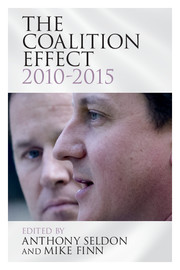Book contents
- Frontmatter
- Contents
- Contributors
- Acknowledgements
- David Cameron as Prime Minister, 2010–2015: The verdict of history
- Part I The coalition and the government of Britain
- Part II The coalition and policy
- 6 The coalition and the economy
- 7 The coalition and energy policy
- 8 The coalition and infrastructure
- 9 The coalition and society (I): Home affairs and local government
- 10 The coalition and society (II): Education
- 11 The coalition and society (III): Health and long-term care
- 12 The coalition and society (IV): Welfare
- 13 The coalition and foreign affairs
- 14 Europe: The coalition's poisoned chalice
- 15 ‘What the coalition did for women’: A new gender consensus, coalition division and gendered austerity
- 16 The coalition and culture: ‘Bread, circuses and Britishness’
- Part III The coalition and political culture
- Part IV Conclusion
- Index
16 - The coalition and culture: ‘Bread, circuses and Britishness’
Published online by Cambridge University Press: 05 April 2015
- Frontmatter
- Contents
- Contributors
- Acknowledgements
- David Cameron as Prime Minister, 2010–2015: The verdict of history
- Part I The coalition and the government of Britain
- Part II The coalition and policy
- 6 The coalition and the economy
- 7 The coalition and energy policy
- 8 The coalition and infrastructure
- 9 The coalition and society (I): Home affairs and local government
- 10 The coalition and society (II): Education
- 11 The coalition and society (III): Health and long-term care
- 12 The coalition and society (IV): Welfare
- 13 The coalition and foreign affairs
- 14 Europe: The coalition's poisoned chalice
- 15 ‘What the coalition did for women’: A new gender consensus, coalition division and gendered austerity
- 16 The coalition and culture: ‘Bread, circuses and Britishness’
- Part III The coalition and political culture
- Part IV Conclusion
- Index
Summary
Overview
‘Whenever I hear the word “culture”,’ observed Hermann Göring, ‘I reach for my revolver.’ Coalition ministers did not find it necessary to go armed when applying draconian cuts to public expenditure in the arts. Victims (including supernumerary quangos) made token protests or simply agreed. Those who had prospered at New Labour's feast could scarcely object to coalition famine. In anticipation of their demise, certain organizations craftily anticipated their own salvation (see English Heritage and British Council, below). Of all areas of public policy stitched together by the coalition, the development of the arts and cultural institutions appeared least contentious. It was most likely to evoke what Winston Churchill described as ‘the broad harmony of thought’ that linked Tory and Liberal philosophy. However, the beginning was scarcely equitable. The Liberal Democrats’ coalition voice in the conduct of cultural policy was mute since no elected Liberal Democrats were appointed ministers in the Department of Culture, Media and Sport (DCMS). By the end of the coalition, total DCMS cultural spending reductions averaging 25 per cent, excluding the Olympic and Paralympic Games, at first condemned by the Left as reckless economy, had come to seem normal (see Table 16.1). The Labour Party, in its election manifesto for 2015, did not promise to reverse them.
State-funded theatres, museums and galleries restructured them-selves to save costs. They contrived novel forms of sponsorship. Observing the age of hierarchies passing, they joined the new age of networks. This meant the unstoppable, global growth of social media. It meant that culture was everywhere, and always on; it knew no boundaries and was made outside academies of taste, beyond Britain's historic cultural institutions; it did not seek official approval because it did not need it.
The National Gallery bowed to the inevitable and permitted visitors to photograph paintings on display.
- Type
- Chapter
- Information
- The Coalition Effect, 2010–2015 , pp. 430 - 464Publisher: Cambridge University PressPrint publication year: 2015
- 1
- Cited by



